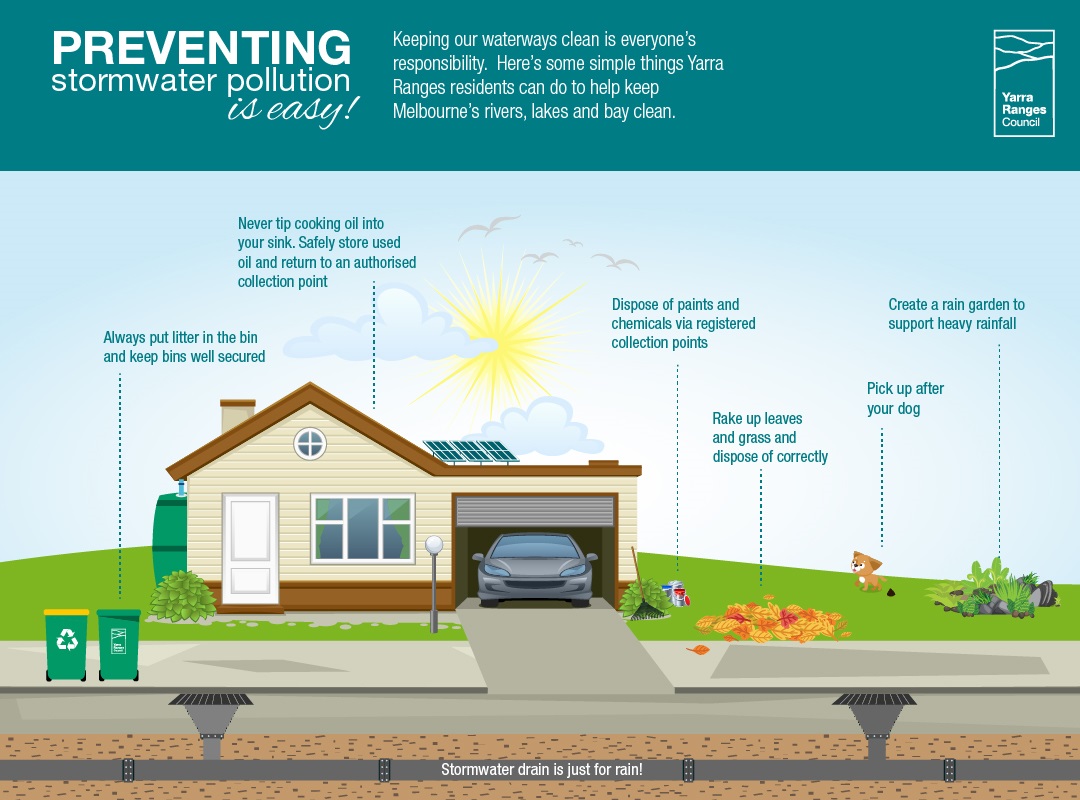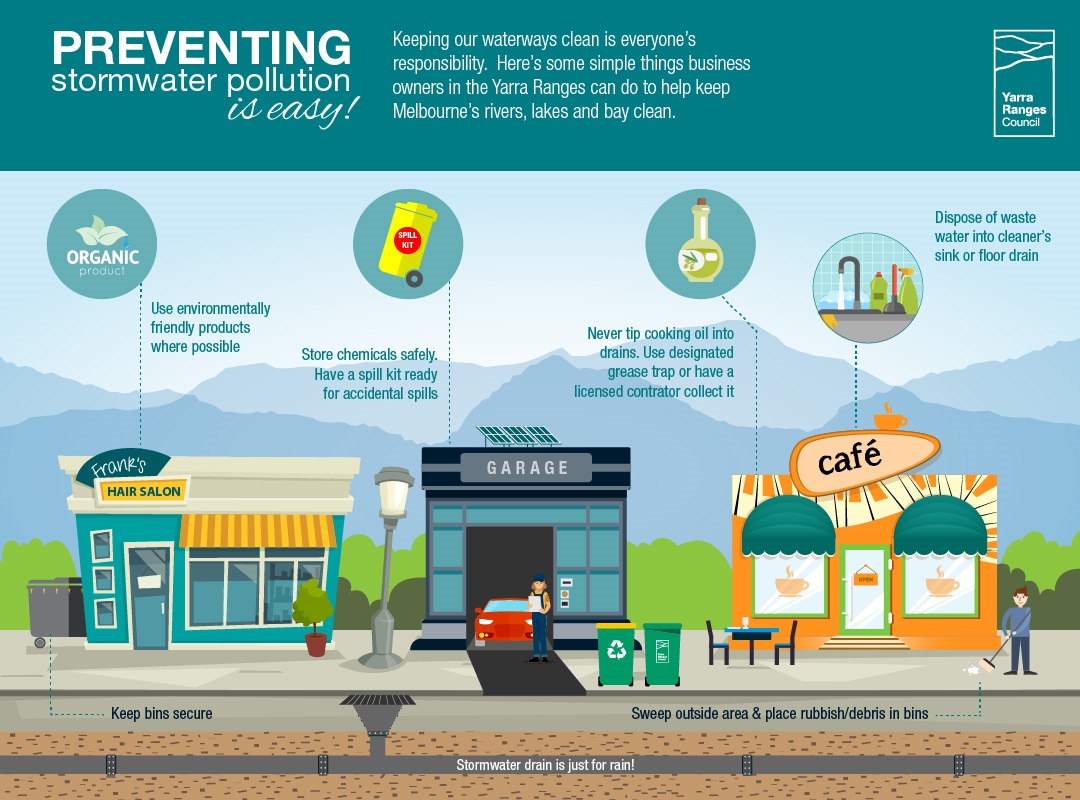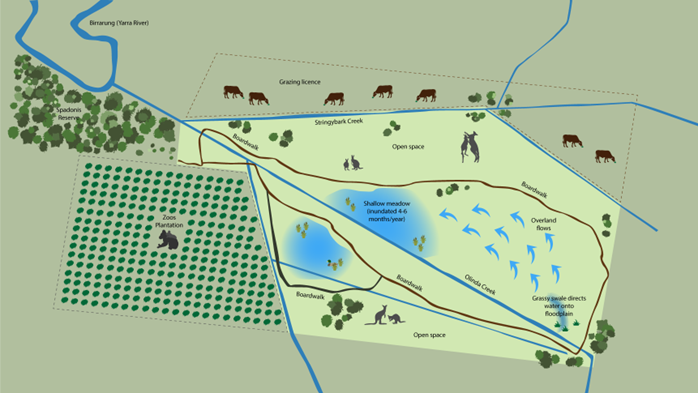Melbourne Water is the lead agency for implementing the Yarra Strategic Plan (Burndap Birrarung burndap umarkoo) 2022–32. The plan gives effect to the community’s long-term vision for the Yarra and supports collaborative management of the river and its lands.
Delivering the plan is a Victorian Government commitment to protect our treasured Yarra River, Birrarung, and its parklands for future generations.
View the Yarra Strategic Plan Word Document(DOCX, 16MB)
View the Yarra Strategic Plan PDF(PDF, 10MB)
Learn more about the The Yering Billabongs Project which is a priority project of the Yarra Strategic Plan.
Healthy Waterways for Residents

When it rains water runs off roofs, roads and any other surface into the nearest stormwater drain. This is collectively known as stormwater.
Pollutants like oils, grease and detergents can be carried into stormwater drains. These pollutants end up in our rivers and creeks and eventually into Port Phillip Bay.
Stormwater pollutants damage our waterways and impacts the health of plants, animals and people as we swim, boat or fish in the waterway.
Here are some tips to help keep our waterways healthy:
- Always put litter in a bin and recycle
- Pick up after your pet
- Rake leaves and grass; garden waste that ends up in the drain decomposes and releases polluting nutrients into the waterway. Turn garden waste into mulch or compost or place in the green waste bin.
- Maintain your septic system to prevent leaks from your property. Learn more about septic systems
- Dispose of paints and chemicals at recycling centres as they are toxic to our waterways and local wildlife. Learn more about paint and chemical disposal
Useful resources to keep waterways healthy
Here are some useful resources you can use to help keep waterways healthy:
Healthy waterways for Businesses

When it rains, water runs off roofs, roads and other hard surfaces into the nearest stormwater drain. This is collectively known as stormwater.
Litter, oils and other pollutants can end up in stormwater drains as a result of residents and businesses. Businesses operating in the Yarra Ranges have a responsibility to ensure pollutants aren’t entering waterways and endangering local plants and animals.
Use these tips below to ensure your business is helping to keep our waterways clean.
Waste Water Disposal
Waste water results from business operations. Examples of business waste water are:
- dirty water from cleaning surfaces and floors
- dirty water from business activities such as washing hair, dog washing, vehicle washing
- water that flows through sinks, toilets and floor drains to the sewer or septic system.
Waste water must be disposed of correctly. Commercial kitchens must discharge their waste water into the sewer or designated cleaner’s sink.
Never tip waste water into gutters or street drains
Waste Management
All commercial food businesses must be registered with the local water authority (Yarra Valley Water, South East Water) and have a licence or permit to discharge waste water into the sewer. This is called a Trade Waste Consent Agreement.
Food businesses that use cooking oils must have a fitted, fully functioning grease trap or have a licensed contractor collect it.
Businesses that have specific waste outputs such as; manufacturers, auto shops and agriculture must dispose of any business waste in line with regulations. For more information about responsible ways to ensure your business isn’t polluting our waterways visit the EPA website
NEVER tip oils, paints, solvents or any pollutant onto the ground or down a drain.
Chemicals and Liquids
Store chemicals, liquids and liquid waste in appropriate containers in an area where a spill can be contained and easily cleaned up.
Spill kits are available in various sizes and should be on-hand ready for use. As a business owner it’s your responsibility to ensure you, and your staff, know where the spill kit is, and how to use it.
For more information on storing, handling and dealing with liquid spills visit the EPA website.
ALWAYS store and handle chemicals responsibly and be prepared for spills.
Litter and Rubbish
Keep the area around your business clean – sweep paved areas and pick up any litter. Ensure bins are secured and can’t tip over or be opened by wildlife. If you have a designated outdoor smoking or lunch area for staff, ensure bins with lids are provided.
ALWAYS secure your bins to stop litter entering waterways.
Staff Training
Make your staff aware of the dangers of stormwater pollution. Ensure they know the location of (and difference between) stormwater drains, sinks and grease traps. They should also have a clear understanding of what waste belongs where for your specific business.
Appoint a staff member as your ‘Environmental Champion’.
Environmentally Friendly Products
Always try to use non-toxic environmentally friendly products.
Platypus are only native to Eastern Australia and Tasmania and are found in the waterways of the Yarra Ranges. Research is showing that the Platypus is in decline and the Communities for Platypus works with the community to raise awareness for the Platypus and keeping our waterways clean. Artworks have been created to raise awareness of Platypus in the waterways. This includes murals at Belgrave and Warburton and sculptured rocks in Healesville.
Some of the common threats to the Platypus:
- Opera house net are illegal in public waterways but are used to catch yabbies', these unfortunately trap platypus and they drown.
- Litter including plastic bags, elastic bands and plastic rings travels into our waterways which can entangle and kill Platypus.
Some of the ways in which you can help the Platypus:
- Snip bands and plastic rings before you bin them.
- Carry your own reusable shopping bags to reduce plastic bags.
- Use hoop nets as an alternative to opera house nets.
- PlatypusSPOT allows you to plot your Platypus sighting in an app or online to help with research on Platypus numbers and locations.
Stencil kits depicting the relationship between our local creeks, rivers and waterways and the sea and the impact litter and pollution can have are now available for loan at Your Library.
The kits can be used by:
- community groups
- schools
- business
- individuals

Stencil Kits Available
Small Stencil Kit
This kit is suitable for clothing, tote bags, tea towels or other cloth items, gift bags, paper or stationery items.
It can also be used on walls, fences, driveways and paths on your own property.
Giant Stencil Kit
This kit is perfect for walls and fence, concrete carparks, paths, buildings.
If you want to use this stencil in a public place you must seek permission first. Please contact Council on 1300 368 333.
Find out more about these kits below
This project was funded by the Department of Environment, Land, Water and Planning.

The Yering Billabongs Project will restore 60 hectares of floodplain along the Yarra River and Olinda Creek. This project will provide stormwater management at a strategic point in the Yarra’s rural reach, enhance biodiversity at a critical point on the floodplain and support diverse cultural, recreation and environmental opportunities for generations to come.
This project prioritises reciprocity of knowledge between Traditional Owners, land managers and land and waterway officers. It will strive to incorporate the principles of Dadirri and Mirrim ngarn ga (deep listening).
The proposal supports the draft priorities and values identified for the Lower Rural Reach in the Yarra Strategic Plan and sit within the identified area of protection for billabong systems between Yering and Tarrawarra.
The following objectives have been developed in consultation with the Working Group and will shape the project outcomes:
- Improve quality of stormwater entering Yarra River from the Olinda, Stringybark and Muddy Creeks through the creation of shallow, ephemeral wetlands to filter pollutants and reduce silt entering the Birrarung.
- Restore wetlands, riparian condition and floodplain connectivity of the lower Olinda, Stringybark and Muddy Creeks to improve water quality, reinstate natural flow patterns and enhance wetland habitat for fauna and flora impacted by historic land use along the lower reaches of the Yarra River.
- Recognise Indigenous ways of knowing, being and doing by working closely with Traditional Owners and creating a space to share knowledge, support and develop cultural land management practises.
- By 2030, create two iconic billabong reserves (Spadonis & Murrup Brarn) – stepping stones for habitat, recreation and cultural heritage – in the lower rural reach of the Yarra.
